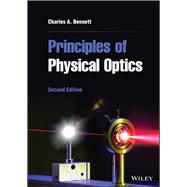An intuitive and accessible approach to the fundamentals of physical optics
In the newly revised Second Edition of Principles of Physical Optics, eminent researcher Dr. Charles A. Bennet delivers an intuitive and practical text designed for a one-semester, introductory course in optics. The book helps readers build a firm foundation in physical optics and gain valuable, practical experience with a range of mathematical applications, including matrix methods, Fourier analysis, and complex algebra.
This latest edition is thoroughly updated and offers 20% more worked examples and 50% more homework problems than the First Edition.
Only knowledge of standard introductory sequences in calculus and calculus-based physics is assumed, with the included mathematics limited to what is necessary to adequately address the subject matter. The book provides additional materials on optical imaging and nonlinear optics and dispersion for use in an accelerated course. It also offers:
- A thorough introduction to the physics of waves, including the one-dimensional wave equation and transverse traveling waves on a string
- Comprehensive explorations of electromagnetic waves and photons, including introductory material on electromagnetism and electromagnetic wave equations
- Practical discussions of reflection and refraction, including Maxwell’s equations at an interface and the Fresnel equations
- In-depth examinations of geometric optics, as well as superposition, interference, and diffraction
Perfect for advanced undergraduate students of physics, chemistry, and materials science, Principles of Physical Optics also belongs on the bookshelves of engineering students seeking a one-stop introduction to physical optics.









